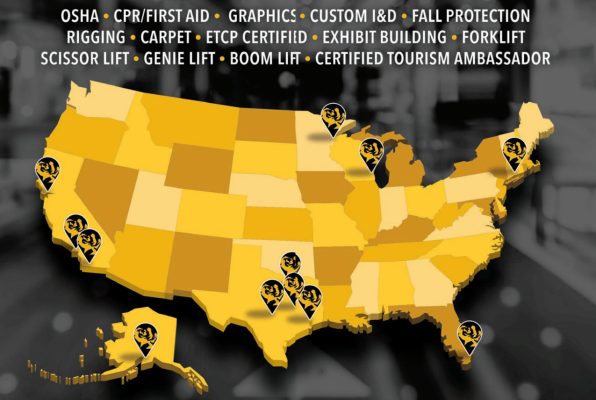Two Associations with Renewed Visions and How it Affects the I&D Supplier Segment
 Pictured at right, the exhibit hall from EDPA ACCESS 2016. EDPA ACCESS 2016 Photo by Padgett & Company Inc.
Pictured at right, the exhibit hall from EDPA ACCESS 2016. EDPA ACCESS 2016 Photo by Padgett & Company Inc.
More than any other marketing tactic, the trade show experience is dependent upon place. Trade show participants and attendees are subject to the host city’s restaurants, accommodations, culture, laws, and resources.
Because a tradeshow is deeply rooted in place, central organization remains one of the biggest challenges that the tradeshow industry faces. Arguably, the exhibit appointed contractors could be the most fragmented segment. Without a national union, everything from the rates to the protocols vary from place to place.
An association regulating from a national level is needed to increase efficiency, quality, and safety through accreditation, best practices, and trend monitoring. Associations can elevate safety and quality to a national standard, thereby increasing efficiency and customer experience. The two associations attempting to tackle this challenge are evolving with the needs of the industry and recently announced renewed visions.
The Only Association Dedicated to the EACs
Recently known as E2MA, the Exhibitor Appointed Contractors Association (EACA) is the latest evolution of associations addressing the needs of the EAC. It’s rooted in an association that was founded in 1998 to be the voice for the “non-official” trade show contractors.
At that time, the industry was experiencing significant growth and the EACs emerged as an alternative service to the general contractor. Show organizers, who previously only worked with the general contractor, were then responsible for a group of independent contractors. The EACs added another layer of complexity and raised concerns around safety, security, and assumption of risk.
The segment’s growth was like the wild west that encountered lesser shops hanging a shingle outside their door. Without accreditation for new companies, the EACs posed safety, security, and liability issues for the show organizers. The show organizers then had to vet the EACs before allowing them to work – and would charge a fee for this vetting process, which was passed on to the exhibitor or cut into the EAC’s profit margins.
A solution was needed for the EACs to remain competitive with the general contractors. In response, an association was founded to streamline the vetting process for EACS and remove the need for the show organizer’s fee. Jim Wurm, who was one of the founders and is the president of the EACA, said, “We worked on processes to enhance safety and security, so that members of the association are aware of best practices to perform work, and how to collaborate with others on the show floor.” A company’s membership within the association became the stamp of approval for show organizers.
Future of the EACA
The EACA continues to manage the relationship between show organizers, exhibitors, and the EACs. Now that the association has accredited the contractors for their hard skills, the latest evolution of the EACA focuses on increasing the value proposition of EACs by teaching soft skills.
From studying the show organizers’ customer survey results, the exhibitor’s customer experience stuck out as the gap for improvement. Senior marketers, who do not usually work outside the office environment, are unaccustomed to interfacing with I&D crews. Working in a new environment and handling the everyday stressors of booth set-up, the trade show floor can be a tense place.
Through its training program, the EACA teaches workers soft skills to enhance the customer experience for exhibitors. The teaching is rooted in helping the worker understand the customer’s point of view: that they are anxious, not in their usual workspace, and do not have the same knowledge of the building or local contacts as the worker does. In the training program, workers also learn that their job entails more than just the physical work of installing and dismantling an exhibit – it includes customer service.
“We teach the workers that the customer may have needs other than installing the exhibit and that they can be resources for the customers. The worker can find-out what the customer needs, answer their questions, and point them in the direction of solving a problem,” said Wurm. “For example, the worker’s job is to erect the display, but the customer might need a specialty piece of furniture, or plants need to be replaced. The worker may have other relationships in the convention center and could point the customer in the direction of people who have the answers.”
Upon completion of the training, workers receive a certificate that makes them more desirable for hiring. However, unlike other industries that compensate for extra training, I&D workers are not likely to receive a pay bonus or increased rates for earning the certificate. If they’re in the union, the flat hierarchy and rate card poses a challenge for motivating workers to exceed the standard.
Yet the trade show industry is rooted in relationships. Helping workers understand that they need people skills, more than just skills with their tools, will build relationships and make the show floor a friendlier place.
Association for the Exhibitor Ecosystem
While the EACA is focused on the interests of the exhibitor appointed contactors, the Exhibit Designers and Producers Association (EDPA) has a macro view of the industry. Founded in 1954, the EDPA’s mission is to advance the interests of members engaged in the design, production, and service of exhibits, events and experiential environments.
Most of its members represent the design production houses, but the EDPA watches for trends that affect exhibitor and the entire trade show ecosystem – including interests for supplier segments like the EAC.
Announced at ACCESS 2016, the EDPA is now focused on expanding its global reach and forming international partnerships for its members. For the I&D supplier segment, which is a uniquely American service, this means connecting with exhibit design houses as their partner. The I&D supplier segment is a uniquely American service that is difficult to navigate for the foreign exhibitor. Businesses exhibiting in the U.S. for the first time depend on their partnerships with domestic design houses to work with the I&D suppliers.
Win for the Exhibitor is Win for All
Understanding that the industry is fragmented, both associations focus on exhibitor as the point of unification. “To put on a trade show, many different parts come into play: the facility, organizer, contractors, local union…if the exhibitor experience is positive, then they all get a win,” said Wurm. If the exhibitor has a positive experience, then they will want to return and each player benefits again.
Kelli Glasser, 2016 President of EDPA, echoed the core of serving the exhibitor. “We represent the exhibitor’s voice in everything that we do and are concerned with everything that affects our industry, because it affects the exhibitors.”




























